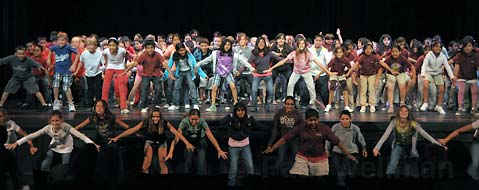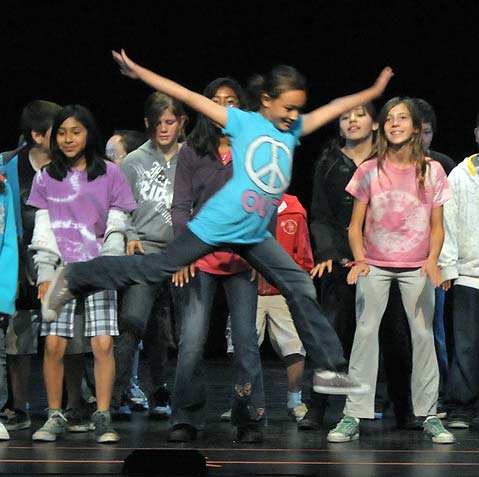Santa Barbara Dance Institute Prepares for End-of-Year Show
Director Rosalina Macisco Introduces Solvang, Cesar Ch¡vez Students to the Stage

It’s 3 p.m. on a Tuesday afternoon, and on Santa Barbara’s lower Eastside, a highly trained SWAT team moves in unison across an elementary school playground. They march in tight formation, bodies taut, faces focused. From the speakers of a nearby stereo come the pumping beats of Deee-Lite’s 1990 smash hit, “Groove Is in the Heart.”
These are the fifth and sixth graders of Cesar Ch¡vez Charter School, and together they form a Super Wonderful And Talented (SWAT) team: an elite group of dancers taking part in one of Santa Barbara Dance Institute’s (SBDI) after-school programs. Behind them stands SBDI founder and director Rosalina Macisco. She leans forward, knees bent and hands on thighs, and calls out counts in time with the music. The dancers respond, bouncing in place for eight counts, then stepping side to side, then spinning and clapping. As if they are part of one body, they surge forward and drop to the ground, their hands hitting the blacktop just as the song hits its final note.
This Sunday, May 31, these students and nearly 300 others from Solvang Elementary and Cesar Ch¡vez Charter School will perform in SBDI’s end-of-the-year show at the Marjorie Luke Theatre. They are third, fourth, fifth, and sixth graders who since September have been taking weekly dance classes at school. Many have never performed on a stage before, and some may never do so again. As far as Macisco is concerned, it doesn’t matter. “We’re not trying to train professional dancers,” she explained. “We’re giving them skills for life.”
Growing up in a half-Puerto Rican, half-Italian family in New York City, Macisco discovered the joy of dance early on. She studied ballet and jazz, and at age 11 saw He Makes Me Feel Like Dancin’, a film about New York City Ballet principal dancer Jacques d’Amboise, who founded the National Dance Institute. “When I saw that film, I thought, ‘I want to dance with him,'” Macisco remembered. She went on to a career in musical theater, acting, and modeling, but could not forget her vision of in-school dance education that reached all children, not just those who had the means to take classes at a studio.
In 2005, Macisco took the plunge: she moved to Santa Barbara, and using the National Dance Institute as her model, founded SBDI. The nonprofit’s primary goal is to teach children to believe in themselves. Now in her fourth year, Macisco says she’s able to see the difference the program is making.
“In my first year at Cesar Ch¡vez, there was a boy who would not move his body,” she said. “We were lucky if we got him standing. Then he started to try a little bit. There was this tough step, and he got it. When I saw that happen, I broke the class into small groups and I made him the teacher of his group. The next thing we knew, he was dancing at home for his family, and at school he was asking his teacher when it was time for dance class.”
Fourth-grade teacher Leanne Patterson said she’s amazed at Macisco’s success with her students at Cesar Ch¡vez. “She’s really consistent with them,” Patterson said. “Her mantra seems to be: Whatever you do, do it with excellence. They love dance class. They’d be absolutely depressed without it.” Patterson also noted that the fact that Macisco is bilingual makes a big difference at Cesar Ch¡vez, where about 80 percent of the upper-grade students are native Spanish speakers.
It’s this kind of feedback that keeps Macisco going in an era when funding is hard to come by and arts programs in schools are threatened. So far, SBDI has relied primarily on foundations for financial support, but now is turning to private donors for help. “The question I am dealing with is: Is dancing a luxury, or a priority?” Macisco explained. “I believe that in a time of economic crisis like this, we need innovative, creative thinkers. We have schools that teach academic excellence, but that kind of education leaves a whole realm of the mind untouched. The pressure to ‘teach to the test’ is huge, so we’re educating our kids out of their creativity, raising them to be afraid to be wrong.”
The solution, she believes, is to bring the creative and performing arts back to the center of a child’s education.

Lest anyone doubt that dance class is real learning, Macisco is adamant about her structured approach. “I bring the strictness of ballet class into every space,” she explained. “There are games and challenges, but it’s also about perfecting a step. In math class, you can’t see if they’re doing their work with 100 percent enthusiasm and commitment. In dance class, you can.” Rather than focusing on alignment or technique, Macisco judges a student’s success by how hard he or she works. The style of dance Macisco teaches is a blend of hip-hop, street jazz, and pedestrian movement. It’s rhythmic and physical, and the kids seem to love it, boys included.
At a technical rehearsal at the Marjorie Luke Theatre nine days before the show, Solvang School fifth-grader Savannah Avery slipped into the seat next to me. She has been dancing with SBDI since she was in third grade. “It really takes my mind off school and makes me feel happy about life,” she told me. “I like everyone on my team.” Whereas in the younger grades, SBDI classes are a part of the school day, in the upper grades they try out for the after-school SWAT teams. When asked whether the boys who choose to take part ever get teased for dancing, Avery looked at me with distain. “Nobody gives them a hard time,” she said. “Everybody gets it.” Solvang School third-grade teacher Julene Fenenga said Macisco’s classes have street cred among her students. “At first they’re really hesitant about the whole thing, especially the boys,” she explained. “But once they meet Rosalina and hear the music, there’s a cool factor, and they buy in.”
That buy-in is evident during the rehearsal for this year’s show, Once Upon a Time: A Wonderful World of Words. It’s an elaborate production with full stage lighting and sound, professional actors delivering voice-overs, and transitions between the dances. To pull it off, hundreds of students have to know their cues and follow directions effectively, not to mention remembering their steps and infusing them with stage presence. It’s a daunting task, but they take it on like seasoned professionals, waiting in silence for their chance to take the stage. From a Dr. Seuss-inspired dance about green eggs and ham to a hip-hop battle based on the poetry of Robert Frost, the show incorporates nursery rhymes, fables, speeches, and novels, weaving its way through the literary standards of an American upbringing. Near the end of the show, four students stand in a row downstage, chins lifted, hands in fists, and arms held high as the voice of Martin Luther King Jr. booms through the theater: “I have a dream.” In that moment, there is no doubt we’re witnessing a dream fulfilled.
4•1•1
On Sunday, May 31, at 3 p.m., Santa Barbara Dance Institute will present its end-of-the-year show, Once Upon a Time: A Wonderful World of Words, at the Marjorie Luke Theatre (721 E. Cota St.). For tickets, call 963-0761 or visit lobero.com. To learn more about SBDI, visit sbdi.org.



